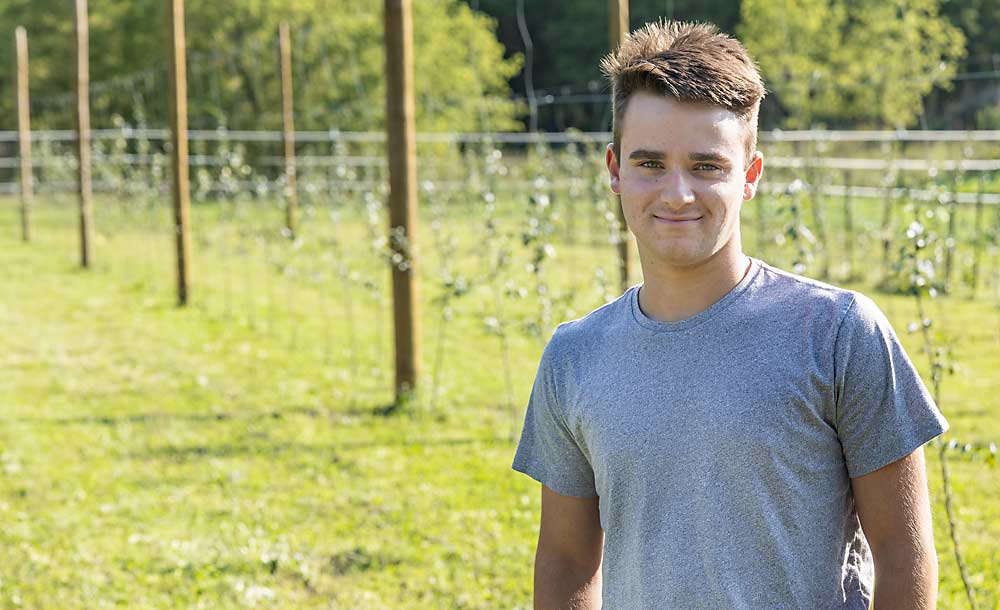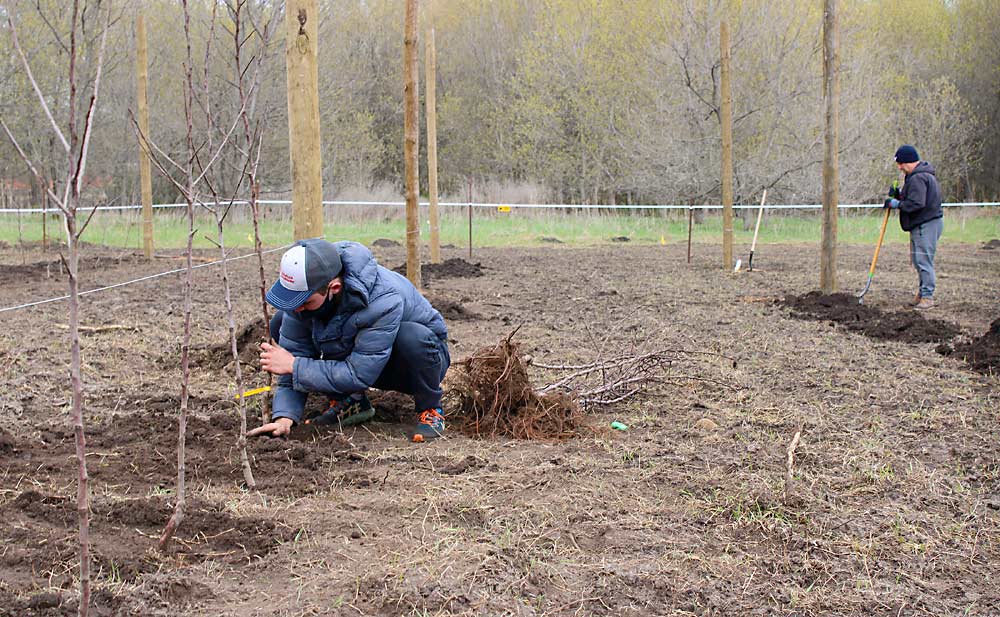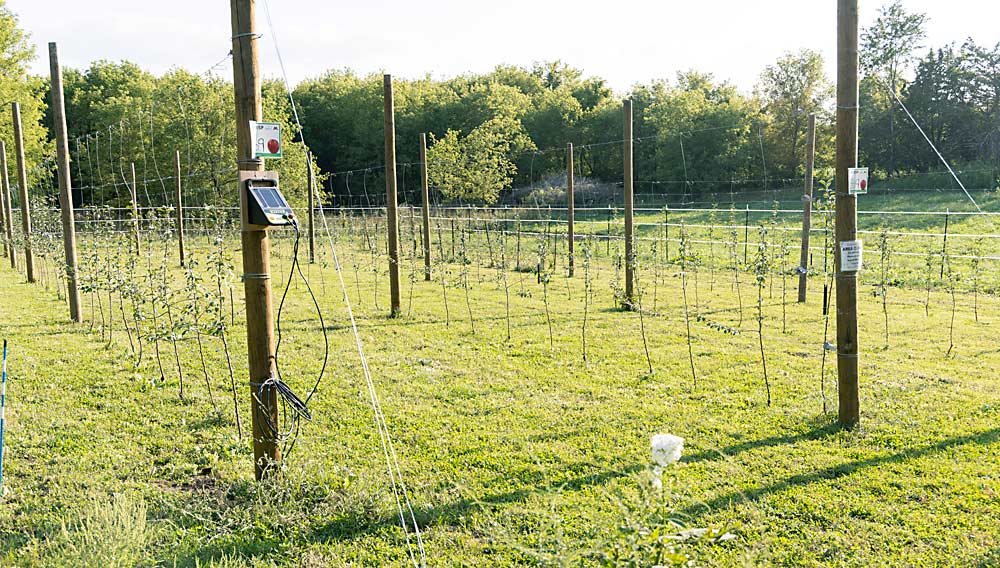
At 4 or 5 years old, Gabe Olson-Jensen’s parents found him carrying 8-pound bricks to his sandbox to try to build his own kiln.
At 14, already fascinated by the fruit breeding process, he was planting seeds, making crosses and grafting his own trees.
At 16, he was awarded nearly $10,000 in grant money to establish and study a block of organic Honeycrisp trees, which he proceeded to do.
Now 17 and a high school junior in River Falls, Wisconsin, Gabe has already built himself a network of fruit growers and scientists from across the country who are more than happy to send him pollen, budwood, trees, posts or whatever else he might need to pursue his passion for all things fruit. They all marvel at his ambition.
“I think he’s got a real future in the apple business,” said Mark Christopher, a Wisconsin fruit grower and Gabe’s employer. “If he can pass along some of that enthusiasm to others in the next generation, people involved in the apple industry will benefit.”
Gabe’s most tangible contribution to the apple industry so far is the small trial block of organic Honeycrisp trees he planted earlier this spring. He aims to prove that organically grown Honeycrisp is a viable option in his area of western Wisconsin and eastern Minnesota, on the outskirts of greater Minneapolis. Straddling the Upper Mississippi River, the region is interspersed with small and medium-size orchards.

“Honeycrisp is the toughest variety to deal with,” Gabe said. “If you can deal with Honeycrisp, maybe you can deal with the new varieties coming down the pipeline.”
As for his future contributions — well, the sky seems to be the limit.
“I am amazed at the way the fruit-growing community has taken Gabe under their wings,” his mother, Wendy Olson, said. “There’s a lot of kind, wonderful people.”
Gabe’s interest in fruit seems all the more unusual because his parents, Olson and her husband, Jay Jensen, are not fruit growers. They are art teachers.
“As parents, we support whatever our kids are interested in, even if we know nothing about it,” said Olson, whose younger son, Elliot, is 14. “When Gabe asked to plant 100 trees on our property, we didn’t say no. We said he had to mow around them and take care of them.”
Gabe’s interest in fruit started in middle school, when he grew citrus and avocado seeds in a school greenhouse. He asked for a grafting tool for Christmas and started grafting every fruit tree he could get his hands on.
About this time, the family was buying apples at Maple Leaf Orchard, a local U-pick and farm market, when Gabe struck up a conversation about grafting and growing with Mark Christopher, who owns the orchard with his wife, Sue. Gabe asked Christopher for a job and the grower hired the “remarkable young man” right then and there.
“When he started talking, I was like, ‘Wow, this kid is interesting. I definitely want him working for me,’” Christopher said.
Gabe has done a little bit of everything at the orchard: weeding and mowing, picking fruit, driving the hayride tractor, running the cash register, helping out in the kitchen and grafting and making crosses.
“That seems to be where his interest lies,” Christopher said. “His interest in crossing and breeding fruits is totally unique.”
Christopher said the other kids on the summer work crew jokingly call Gabe “grandpa” because of his uncommon level of maturity.
Gabe joined FFA in ninth grade. He learned about a plot of land owned by the school district that was being leased by FFA for agricultural projects, and he started inquiring about planting apple trees there. He was reading about high-density plantings at the time and had already planted dozens of high-density apple trees in his backyard. But he wanted a bigger research site.
When the coronavirus pandemic shut down his school in spring 2020, the freshman found himself with a lot of time on his hands, so he started studying grant writing. He first applied for an FFA grant of $600. When he got that, he decided to apply for a bigger grant from Sustainable Agriculture Research and Education, a competitive grant program established by the U.S. Department of Agriculture. A few months after he submitted a funding request for his organic Honeycrisp project, an email told him he would be receiving $8,945.

“I was in shock for several days,” Gabe said.
The next step was asking the school district for permission to plant a trial block on its land. He met with the school board to discuss the project. The board approved — with much enthusiasm, his mother said.
A lot of people pitched in for Gabe’s self-described “crazy endeavor.” In the spring, family, friends and FFA alumni helped him dig holes, plant trees, secure posts and wires, and set up an electric fence to keep deer out. FFA donated an old entrance gate. They spaced the Honeycrisp trees — half Premier and half Firestorm — at 3 feet by 16 feet on Geneva 969. Gabe hopes the trees will start fruiting in three years. There’s also a short row of Ludacrisp trees on G.935, which the Midwest Apple Improvement Association sent him for free.
“His excitement is contagious,” said MAIA president Bill Dodd. “It’ll be interesting to see what he does with his passion.”
John Jacobson, an apple grower in eastern Minnesota, sold Gabe some posts for the project. The teenager has visited Jacobson’s orchard a number of times to study how he grows fruit.
“I’m really excited that someone has developed that passion so early on,” Jacobson said. “I want to encourage him: Keep going, man. You can do very, very well.”
Gabe still doesn’t know exactly what he wants to do when he grows up. He knows it will involve growing fruit, either as a hobby or a full-time endeavor. He’s also considering a research career, probably starting with a horticulture degree from the University of Wisconsin-River Falls.
So, what is it that drove Gabe to plant a research orchard at 16, when he could have been playing video games with his friends?
“I get more fulfillment doing this,” he said.
Olson wonders if her son will end up helping schools and nonprofits plant organic orchards and grow fruit for their communities.
“I don’t know if such a job exists,” she said. “But if it doesn’t, Gabe would have the ambition to make it happen.”
—by Matt Milkovich






Leave A Comment